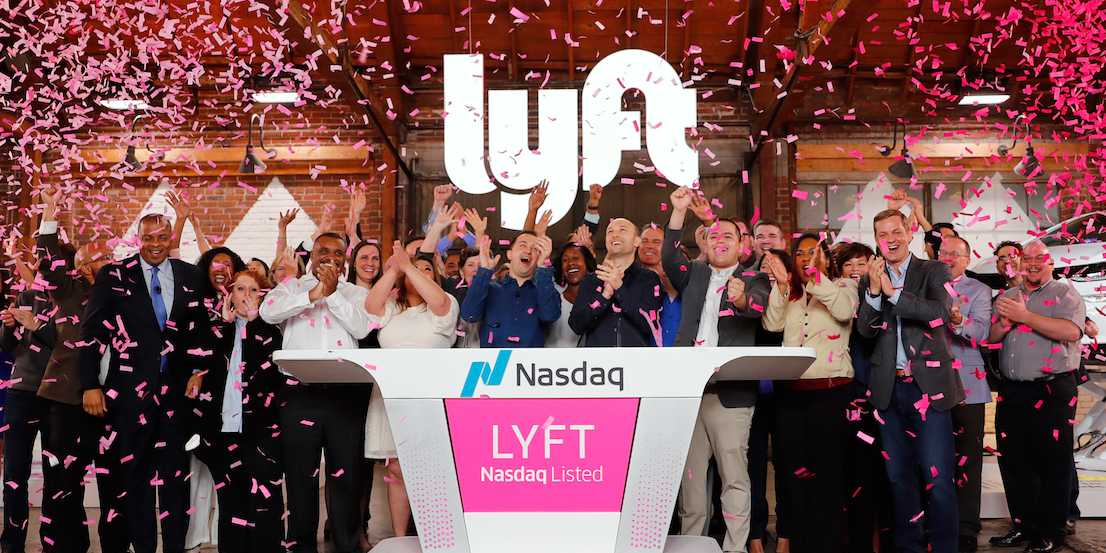- Lyft’s losses are growing, and the company could be years from profitability.
- That hasn’t suppressed Wall Street’s appetite for stock of the ride-hailing company, which went public on Friday.
- The company’s oversubscribed initial public offering was priced above its original window and spiked more than 20% in trading.
- Wall Street analysts have yet to issue a sell rating for the stock, but all coverage is markedly bullish thus far.
Lyft lost $911 million last year.
That’s more than the company lost in 2017, when it lost $688 million, and more than 2016’s loss of $682 million.
It’s almost counterintuitive, on the surface at least, that big-name investors would be clamoring at the gate and packing hotel penthouses to get a piece of a company so deeply in the red, but that’s exactly what’s happening with Lyft’s initial public offering.
The stock was priced at $72 Thursday evening and quickly soared to above $87 per share when it began trading Friday morning, translating to a massive market value of roughly $29 billion.
Read more: Lyft's founders are set to make more than $1 billion in the company's IPO
That interest was fueled by bullish targets set by some of Wall Street's first analysts to launch coverage of the stock. Only four analysts have set price targets or valuations for the stock, but none of them are bearish on the company's long-term prospects.
"While profitability is key," the Wedbush analyst Dan Ives said, "we expect more driver incentives to be offered by Lyft over the next few years as the company needs to expand its drivers and peak house in the US, especially with Uber aggressively going after this market in major cities."
In other words, investors and analysts are focused on growth above all else.
And there's plenty of room to run. Lyft has pitched investors on its "transportation-as-a-service model" that could eventually upend traditional car ownership as we know it. It's a big ask, but that "golden opportunity," as Ives puts it, could be worth the $1.2 trillion American consumers spend on transportation each year.
And Lyft's executives, for their part, don't seem very worried about the negative cash flow either. When pressed by Bloomberg's Eric Newcomer on Thursday, the company's cofounder Logan Green dodged the profitability question: "We cannot talk about the future," he said, "but what we can tell you is that we have set ourselves up to deliver long-term shareholder value."
To be sure, profits are still on analyst's minds, but a money-making investment can easily be made on a money-losing company. Take Tesla, for instance, which at one point held a book valuation bigger than some of the US's largest automakers despite its negative cash flow.
"Lyft has a more focused geographical footprint and product portfolio than its largest competitor, but appears to be several years away from profitability," Tom White, an analyst at D.A. Davidson, told clients this week in publishing his ignition with a buy rating.
"Near term, Lyft's ability to reduce incentives for drivers and riders (critical tools for creating balance in its ridesharing marketplace) will be a key lever to its near term profitability outlook," he added.
More Lyft IPO coverage:
- Lyft is about to go public. Here's what the first Wall Street analysts to cover the stock are saying.
- Lyft moved its San Francisco roadshow meeting at the last minute amid protesting drivers
- Inside the Lyft roadshow in NYC, where investors packed the penthouse of a $1,000-a-night hotel
- A $3 billion investment chief breaks down the strategies he expects traders to use around the Lyft IPO - and reveals how his firm is planning to play it
- A 'warrior's warrior': Why insiders say the first-time CFO running Lyft's $20 billion IPO is the perfect fit

